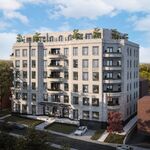The costs to build the YUS extensions are hyper-inflated and ergo make for an unfair comparison as to what can be accomplished along Eglinton. What part of the Eglinton subway alignment has to tunnel beneath a riverbed or highway system or require a new storage facility or mass 27-bay underground bus terminal or be exclusively in a tunnel bore?
Eglinton - Airport subway would have to cross: Hwy 427, Hwy401, Humber River, Black Creek in the west; Don West, Hwy 404, Don East in the east.
Spadina extension has to cross only Hwy 407 and Black Creek (where it is much smaller than at Eglinton), and is positioned conveniently close to the Wilson Yard.
Making Eglinton compatible with HRT technology means that Eglinton trains can utilize Wilson Yard, minimizing the need for a separate storage facility as Wilson still has spare capacity. Davisville Yard is a possibility as well, only one kilometre south of the corridor.
First of all, Wilson Yard quite likely can support Eglinton subway if no other subway extensions were on the table. But will it be able to support Eglinton and all other planned extensions - I am not so sure ...
Secondly, even the construction of service links between Eglinton subway and either Spadina or Yonge will be a challenge, since both intersection areas are pretty much built up.
Btw, this is one difference between Eglinton and Sheppard subways ... if Sheppard is extended to Downsview eventually, it can connect to Wilson Yard quite easily.
By the way on the issue of transferring, where do you think more people will desire to do so: 5 minute long waits at road median LRT sheds exposed to the elements or climate-controlled stations where trains show up every 2’35’’ or better? If your answer is B, please read on.
Those who live near Eglinton, will be even happier if they do not have to transfer at all: just board the LRT and continue to Spadina or Yonge subway.
If roughly half of all southbound trips for major intersecting TTC bus routes (from west to east: 58, 112, 46, 191, 45, 37, 79, 89, 41, 29, 7, 61, 11, 56, 88, 51, 54 and 100) saw majority passenger drop-off at Eglinton, then that’s a steady guaranteed source of ridership. Crunching the numbers: a total of 85,167ppd or 5323pphpd (SOURCE:
http://www3.ttc.ca/PDF/Transit_Planning/service_improvements_2008.pdf).
And note that’s just from non-TC prioritized north-south feeder bus trips alone, not accounting for Jane, Don Mills or Eglinton East’s massive levels of riders that’d also directly feed into an Eglinton subway.
This argument has merit. However, the number of affected passengers will be reduced by other transit projects on the table. In the west: if one lives south of Albion Rd and south of Finch, Eglinton subway would be closest, but for those who live north of that line, Spadina extension is as close or even closer. In the east: a lot of passengers will ride Eglinton to Yonge as long as DRL East does not exist, but if it is built, many will switch to it.
Then consider Mississauga Transit routes- 11, 17, 27, 35, 50, 57, 82, 89, 109 adding in another 10,000+. The Mississauga Transitway will also attract new ridership, those seeking the Point A - B reliability that comes with the subway, not meandering surface trams. This could all lead to the western termini, handling levels of daily boardings not unlike what Kipling and Islington Stns on the Bloor Line are experiencing today.
That makes for a long trip to almost any place of interest in Toronto, even if Eglinton has subway. How many passengers will be interested?
Even the staunchest Transit City supporter agrees that the Cross town LRT will eventually need to be retrofitted to subway technology once ridership exceeds capacity, which is expected to happen within 50 years time. Should we wait until then to fix the problem or resolve an issue before it even manifests?
I am not aware of such forecasts. And frankly, nobody can predict transit demand in 50 years. It depends on so many factors: overall population growth in GTA, location of employment centres, share of telecommuting, even - who knows - new transportation modes.
I'd rather endorse a plan that spans 10 - 25 years and addresses major bottlenecks within that frame.
Even if transit demand on Eglinton eventually approaches the limit of LRT, there are ways to divert some of it to other routes. One option would be an extension of Sheppard subway (west of Downsview stops at major concessions only - fast route - good airport link for the northern half of 416). Another option is Midtown rail line, which could operate faster than any subway.
And how is one singular subway line which can in fact be seamlessly interlined with the Downtown Relief Line at Mt Dennis to offer direct, continuous rapid transit between PIA and Union/Central Business District; any worse than this overly complicated and expensive, somewhat unwarranted commuter rail scheme?
http://transit.toronto.on.ca/archives/weblog/2009/01/22-will_train.shtml
Is all that really necesary when only 17% of Pearson travellers originate from downtown? Would it not just be better to provide rapid transit to some intermediate destinations along the way as the subway can allot? The directness of a seamless DRL-Eglinton subway interline ride with more conscientious stop spacing than Transit City is more beneficial to commuters as a whole whilst being less disruptive to motorists and the community of Weston.
I don't like the TARL plan too much. What I would prefer is an electrified GO line between Pearson and Union with several stops en route. That would be much more attractive than TARL for non-business travelers and for travelers not from downtown. Yet, electrified GO line would be a lot cheaper than a downtown - Pearson subway.
Finally, Eglinton need not cost the City a mint. In fact seeing as the Cross-town LRT is projected to cost $ 5 billion for 30 kilometres, getting 24 kms of subway instead for roughly the same price isn’t that bad of a deal. The central tunneled section of the line has already been estimated at $2.2 billion total. But let us entertain for a second that swapping LRTs for HRT will magically extrapolate the costs. Going by the Spadina extension’s $265 million/km budget, we’ll say it’s $3.180 billion for the 12 km central tunnel. Now the section through all of Etobicoke and east of Brentcliffe would be at-grade or above-grade areas of track. Very generously I’ll say this comes to $200 million/km for the remaining 12 kilometres. That’s still only $5.580 billion total!
Tunneled portion: count in 5 years (at least) of inflation, and the tunnel under the old part of the city, with constrained space and multiple underground communications. In contrast, part of Spadina tunnel will be under empty land. So, I think that $300 million/km would be fair, if not too optimistic, for Eglinton subway tunnel.
Then, Richview corridor does not go through all of Etobicoke, nor across 401 and 427. Assume 6 km of extra tunneling at $300 million/km, and 6 km in the corridor at $200 million/km.
Total: 18 x 300 + 6 x 200 = $6,600 million or $6.6B.
This is $2B greater than the current plan, and does not include the section east of Don Mills at all.




